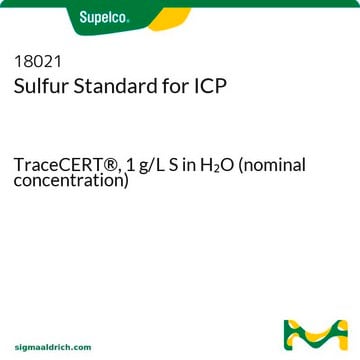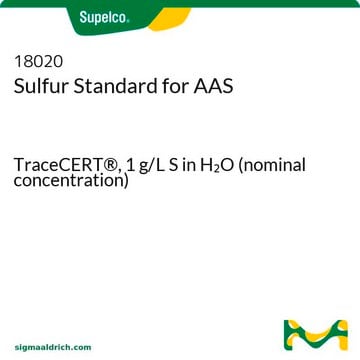Wichtige Dokumente
IRMM643
Schwefel-32S -Lösung
IRMM®, certified reference material, Spike Isotopic Reference Material
About This Item
Empfohlene Produkte
Qualität
certified reference material
Agentur
IRMM®
Isotopenreinheit
32S
Hersteller/Markenname
JRC
Konzentration
371.96 μmol/kg±0.57 μmol/kg 32S in 2.8 M HNO3
Anwendung(en)
general analytical
Format
single component solution
Massenverschiebung
depleted
SMILES String
[32S]
InChI
1S/S/i1+0
InChIKey
NINIDFKCEFEMDL-IGMARMGPSA-N
Suchen Sie nach ähnlichen Produkten? Aufrufen Leitfaden zum Produktvergleich
Verwandte Kategorien
Hinweis zur Analyse
IRMM643
Rechtliche Hinweise
Signalwort
Danger
H-Sätze
Gefahreneinstufungen
Acute Tox. 4 Inhalation - Eye Dam. 1 - Met. Corr. 1 - Skin Corr. 1B
Zusätzliche Gefahrenhinweise
Lagerklassenschlüssel
8A - Combustible corrosive hazardous materials
WGK
WGK 1
Hier finden Sie alle aktuellen Versionen:
Analysenzertifikate (COA)
It looks like we've run into a problem, but you can still download Certificates of Analysis from our Dokumente section.
Wenn Sie Hilfe benötigen, wenden Sie sich bitte an Kundensupport
Besitzen Sie dieses Produkt bereits?
In der Dokumentenbibliothek finden Sie die Dokumentation zu den Produkten, die Sie kürzlich erworben haben.
Unser Team von Wissenschaftlern verfügt über Erfahrung in allen Forschungsbereichen einschließlich Life Science, Materialwissenschaften, chemischer Synthese, Chromatographie, Analytik und vielen mehr..
Setzen Sie sich mit dem technischen Dienst in Verbindung.









